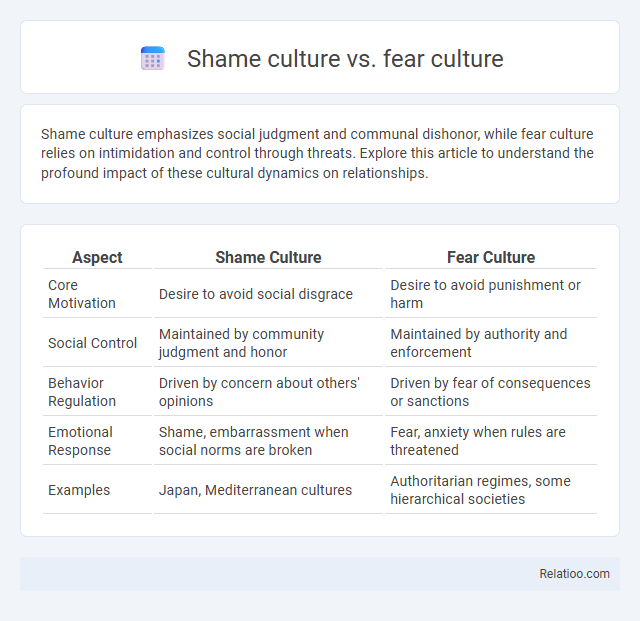Shame culture emphasizes social judgment and communal dishonor, while fear culture relies on intimidation and control through threats. Explore this article to understand the profound impact of these cultural dynamics on relationships.
Table of Comparison
| Aspect | Shame Culture | Fear Culture |
|---|---|---|
| Core Motivation | Desire to avoid social disgrace | Desire to avoid punishment or harm |
| Social Control | Maintained by community judgment and honor | Maintained by authority and enforcement |
| Behavior Regulation | Driven by concern about others' opinions | Driven by fear of consequences or sanctions |
| Emotional Response | Shame, embarrassment when social norms are broken | Fear, anxiety when rules are threatened |
| Examples | Japan, Mediterranean cultures | Authoritarian regimes, some hierarchical societies |
Introduction to Shame and Fear Cultures
Shame culture and fear culture represent distinct social mechanisms that regulate behavior through different emotional responses. Shame culture emphasizes social perception and communal judgment, where your reputation and how others view you dictate your actions, often leading to a deep concern for honor and social standing. Fear culture, in contrast, relies on the anticipation of punishment or harm, driving behavior primarily through fear of consequences rather than concern for social recognition.
Defining Shame Culture: Core Characteristics
Shame culture centers on maintaining social harmony by emphasizing reputation, honor, and communal perception, where individuals regulate behavior to avoid public disgrace. Core characteristics include a strong focus on external judgment, the importance of face-saving, and collective accountability to social norms. Your awareness of this cultural framework helps navigate interpersonal dynamics shaped by group expectations and social consequences.
Understanding Fear Culture: Key Traits
Fear culture is characterized by strict control, where authority enforces compliance through intimidation and threats, creating an environment of anxiety and silence. Key traits include a lack of open communication, high levels of stress among individuals, and decisions driven by avoiding punishment rather than innovation or collaboration. Your ability to recognize fear culture allows you to address toxic dynamics and foster a more transparent and supportive organizational atmosphere.
Historical Roots of Shame and Fear Cultures
Shame cultures historically emphasize communal harmony and social reputation, where individual behavior is regulated by external judgment and honor within tightly knit groups. Fear cultures arise from environments dominated by threats, punishment, and power hierarchies, instilling control through intimidation and compliance. Understanding your cultural background reveals how these contrasting mechanisms shape social interactions and personal identity development across different societies.
Social Mechanisms of Shame-Based Societies
Shame culture relies on external social mechanisms where community judgment and loss of honor drive behavior, contrasting with fear culture that depends on threats and punishment to enforce compliance. In shame-based societies, your social standing and relationships are maintained through public recognition of proper behavior and the avoidance of disgrace. These social mechanisms create a strong collective pressure to conform, influencing interpersonal dynamics and decision-making processes within the group.
Power Structures in Fear-Driven Environments
Power structures in fear culture maintain control through intimidation, surveillance, and punishment, fostering obedience by suppressing dissent and discouraging risk-taking. Shame culture derives influence by manipulating social reputation and communal judgment, ensuring conformity through the threat of public disgrace instead of direct intimidation. Understanding these dynamics helps you recognize how fear-driven environments prioritize compliance over innovation, often stifling individual expression and collective growth.
Psychological Impact: Shame vs Fear
Shame culture triggers profound internalized feelings of worthlessness and self-criticism, deeply affecting an individual's self-esteem and long-term psychological health. Fear culture primarily induces anxiety and hypervigilance, driving behavior through threat avoidance and external control rather than internal reflection. The psychological impact of shame often leads to persistent guilt and social withdrawal, whereas fear prompts reactive compliance and stress-related disorders.
Case Studies: Examples Around the World
Case studies highlight significant differences between shame, fear, and guilt cultures across societies. In Japan, a shame culture emphasizes group harmony and social reputation, where individuals avoid shame through conformity and indirect communication. Conversely, North Korea exemplifies a fear culture, relying heavily on state surveillance and punishment to maintain control, creating compliance through intimidation rather than internalized moral standards. Scandinavian countries often illustrate guilt cultures, promoting personal responsibility and moral reflection, encouraging individuals to act ethically based on internal values rather than external social pressure.
Navigating Shame and Fear in Modern Organizations
Navigating shame and fear in modern organizations requires understanding the distinct impacts of shame culture, fear culture, and their interplay on employee behavior and morale. Shame culture emphasizes maintaining social standing and avoiding embarrassment, often leading to indirect communication and hidden conflicts, while fear culture is driven by control and punishment, resulting in compliance but stifled creativity. Effective leadership fosters psychological safety by addressing these emotional dynamics, promoting transparency, and encouraging open dialogue to enhance trust and collaboration.
Moving Toward a Healthy Cultural Balance
Shame culture emphasizes social conformity through guilt and embarrassment, while fear culture relies on threats and intimidation to enforce behavior, both often undermining individual well-being and authentic connections. Moving toward a healthy cultural balance involves fostering empathy, open communication, and accountability, which encourage personal growth and collective trust without coercion. By recognizing these dynamics, you can cultivate a supportive environment that balances boundaries with respect and empowerment.

Infographic: Shame culture vs Fear culture
 relatioo.com
relatioo.com